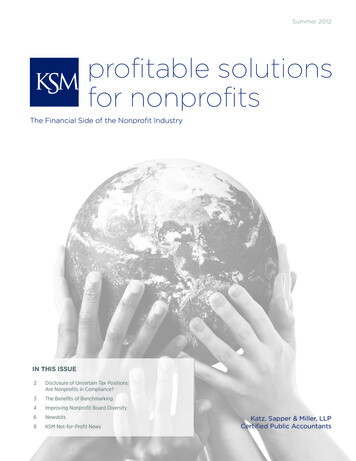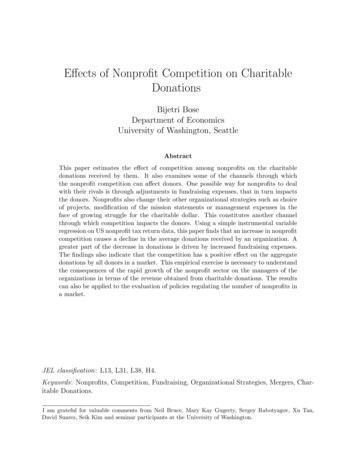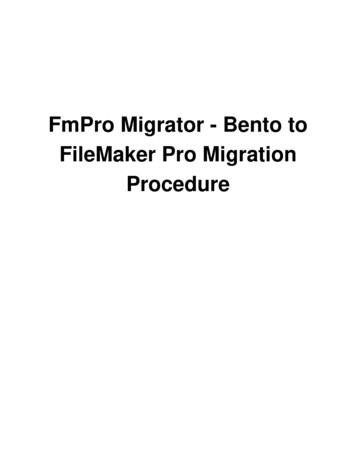
Transcription
Summer 2012profitable solutionsfor nonprofitsThe Financial Side of the Nonprofit IndustryIN THIS ISSUE2Disclosure of Uncertain Tax Positions:Are Nonprofits in Compliance?3The Benefits of Benchmarking4Improving Nonprofit Board Diversity6Newsbits8KSM Not-for-Profit NewsKatz, Sapper & Miller, LLPCertified Public Accountants
profitable solutionsfor nonprofitsDisclosure of Uncertain Tax Positions:Are Nonprofits in Compliance?As a not-for-profit, tax-exemptorganization, one might think that thesubject of “uncertain tax positions” doesnot apply to his or her organization.Think again — some of the basics ofoperations, including the organization’stax-exempt status, could createuncertain tax positions that triggercritical reporting obligations.By Casse Tate, CPA, MSManagerctate@ksmcpa.comFIN 48 in a NutshellFor several years now, the FinancialAccounting Standards Board (FASB) hasrequired taxpayers that prepare financialstatements according to GenerallyAccepted Accounting Principles (GAAP)to adhere to Accounting StandardsCodification Topic 740, Income Taxes,Subtopic 740-10 — more commonlyknown as FIN 48. Under FIN 48,taxpayers must disclose information onuncertain tax positions (UTPs).While FIN 48 applies only to positionsrelated to income taxes, the practicesof some nonprofits could trigger thedisclosure requirement. To determinewhether an organization has UTPs underFIN 48, the organization must engagein a two-step process: recognition andmeasurement.1. Recognition – First, identify the taxpositions and determine whether,based on their technical merits,it is more likely than not (morethan 50 percent likely) that thepositions will be sustained uponexamination by taxing authorities.Assume that the organization will2be audited by authorities who haveall relevant information on theposition.2. Measurement – For each positionthat fails to meet the more-likelythan-not threshold, measure theamount of potential tax liability,including taxes, interest andpenalties. If the aggregate amountof all UTPs is material (that is,the omission or misstatementof the amount could influencethe economic decision ofusers taken on the basis of thefinancial statements), it mustbe disclosed in the financialstatement footnotes (and, in turn,on Schedule D of IRS Form 990).Where financial statements areconsolidated, FIN 48 applies toeach of the consolidated entities,and the UTPs are aggregated forthe consolidated group to see ifdisclosure is required.Remember — FIN 48 applies only toincome tax positions. Positions relatedto sales, use, payroll, excise and othertypes of taxes are not part of theanalysis.The Exemption IssueIt may seem surprising that a taxexempt organization could have anuncertain tax position, but uncertaintymay exist.Continued on page 7. See “Disclosure.”Summer 2012
THE FINANCIAL SIDE OF THE NONPROFIT INDUSTRYThe Benefits of BenchmarkingThe word “benchmark” may strikesome as organizational lingo, but thepractice of benchmarking often provesvaluable for nonprofits. Nonprofits thatincorporate financial benchmarks intotheir operations are better at anticipatingnegative financial trends and may evensee revenues climb, expenses drop andefficiencies improve.By Kirk Taylor, CPAManagerktaylor@ksmcpa.comWhat is Benchmarking?Benchmarking is an ongoing processof measuring an organization againstexpectations, past experience or industrynorms for productivity and profitabilityand then making adjustments to improveperformance in relation to those metrics.Ideally, nonprofits will consider both: Internal benchmarks — to monitorand detect trends, based on theorganization’s historical results andstatistics, as well as expectations,and External benchmarks — to ascertainwhere it is thriving and where it lagsbehind, based on data from peers.Benchmarkingprovidesessentialinformationfor effectivelydeveloping andimplementingstrategic plans.Katz, Sapper & MillerBenchmarking provides essentialinformation for effectively developingand implementing strategic plans. It helpsan organization keep a watchful eye onits financial health and determine wherecosts can be cut and revenues increased.Nonprofits can use benchmarks todemonstrate their efficiency to internalstakeholders such as managementand board of directors, and externalstakeholders such as donors andgrantors.Benchmarks for NonprofitsThe first step is to define what metricsthe nonprofit needs to measure. Focuson the metrics that are most critical tothe success of the mission and the keyindicators of the organization’s financialhealth and operational effectiveness.For many nonprofits, those metrics willinclude: Program efficiency (programservice expenses / total expenses)– This ratio identifies the amountspent on the primary mission, asopposed to administrative andfundraising costs. This ratio is ofutmost importance to stakeholders. Fundraising efficiency (unrestrictedcontributions / unrestrictedfundraising expenses) – Howmany dollars does the organizationcollect for every dollar spent onfundraising? The higher this ratio,the more efficient the fundraising.What qualifies as a good ratiodepends on the organization’s size,its types of fundraising activities,etc. Operating reliance (programservice revenue / total expenses)– This ratio indicates whetherthe nonprofit could pay all of itsexpenses solely from programrevenues. Organizational liquidity(expendable net assets / totalexpenses) – How much of theyear’s total expenses are consideredexpendable equity or reserves?The higher the ratio, the better theliquidity.Continued on page 6. See “Benchmarking.”3
profitable solutionsfor nonprofitsImproving Nonprofit Board DiversityBy Pete Buck, CPADirectorpbuck@ksmcpa.comNonprofit board members areambassadors for the organization.However, a lack of diversity can signalan underlying problem: a disconnectfrom the community. A nonprofit canimprove its funding and programeffectiveness when board membersreflect the population served, as well asthe community. How can a nonprofitevaluate the board for diversity, improveboard diversity, and what other optionsmay be available to consider?Mixing Things UpThe definition of “healthy” diversity willvary from organization to organization,but think of it like this: the more diversea board is in attributes, the more diverseit will be in thoughts and ideas. Thisdiversity can come in various forms suchas: physical, societal or economic. Thegoal is to mirror the population served inappointees to the board.If a nonprofit’s bylaws limit the numberof board members who can serve atany given time, the organization shouldconsider amending the bylaws to includeits commitment to board diversity. Bevery careful that the size of the boarddoes not become unwieldy. There areother ways to commit to well-balancedleadership and community input thatwill be discussed later.Assessing Skills and DemographicsThe first step to a great mix is to askboard members to write their ownprofiles. In the instructions given (or onthe form provided) include the attributesthe organization considers important,such as skill sets and a particular4demographic. From this information, itwill be clearer what the board may lack.Look at the group as a whole and assesswhere the organization lies on thediversity continuum. Imagine a scalefrom “1” to “5” with “5” displaying thenonprofit’s ideal diversity. Assess themembers and give a score. The diversity,or lack thereof, should be obvious.For example, the board may beunderrepresented by females, a certainrace, young adults or individuals with afinancial background.Getting the Word OutIdentifying the need for diversity iseasy. Figuring out what to do about itcan be more difficult. Start with currentboard members. Communicate the needfor diversity (if the need has not beenvocalized already). Ask members todip into their personal and professionalnetworks to help find the rightindividual(s) for the board.Also gather input from the communityand the organizations that serve it. Thechamber of commerce might be a placeto start, but there are many options.If a nonprofit lacks the perspective ofyoung professionals, contact a local“young professionals” group in thearea or recent college graduates. Doesthe organization need diversity via afinancial perspective? If so, expressneeds to a local CPA firm.Continued on page 5. See “Diversity.”Summer 2012
THE FINANCIAL SIDE OF THE NONPROFIT INDUSTRYDiversity(continued from page 4)Seeking External HelpIf it is difficult to find qualified board members, try a board placement service. Somecommunities have board training programs for professionals. At the completion of theprogram, the “graduates” are invited to meet with organizations seeking new boardmembers. This is a great service for both the new board member and the nonprofit.Professional associations also can be a good recruitment resource. Some state CPAorganizations help match accountants with nonprofits that need volunteers. A nonprofitconsultant that assists with board placement may also be able to help.Other Paths to DiversityIf a nonprofit wants to add diversity to its leadership to better mirror the communityor communities it serves, but does not want to increase the board size for fear oflosing efficiency, rather than waiting until a member of the board ends his or her term,nonprofits can increase diversity by appointing new people to these structures now: An advisory board – Often considered an “informal” board, an advisory board canbring additional qualifications and demographics to a nonprofit organization. Anadvisory board is also the perfect training ground for potential leaders. Board committees or subcommittees – Special projects or areas of interest maywarrant recruiting more volunteers to donate time and energy to an organization.If a nonprofit is national, for example, board committees might serve the interestsof particular regions or chapters. Focus groups – Although not a standing structure, focus groups are extremelyuseful in collecting the opinions of particular demographic groups on targetedtopics.Opportunities, OpportunitiesBuilding an effective board of directors should be a challenge that nonprofits happilyface. Every time a board member resigns, an opportunity to continually considerdiversity emerges.Katz,Sapper& MillerKatz,Sapper& Miller5 5
profitable solutionsfor nonprofitsBenchmarking(continued from page 3)Also consider benchmarks such asaverage donor contributions, expensesper member and other ratios thatmeasure trends for liquidity, operatingyield, revenue, borrowing, assetsand similar metrics. No matter whichbenchmarks chosen, though, reliableprocesses will be needed for collectingand reporting the data.For Comparison’s SakeComparing the nonprofit’s performanceto benchmarks allows the organizationto zero in on areas with the greatestpotential for improvement. Armed withthis information, nonprofits may be ableto improve performance without makingsignificant changes in operations.Further, when comparing againstexternal benchmarks, performancemight be improved by simply adoptingbest practices used by peers.Information can be obtained on othernonprofits’ metrics from websites suchas GuideStar.org and CharityNavigator.org or from commercial software.Information also may be available fromstate government databases and tradeassociations. Take steps, though, tocompare apples to apples — that thetwo organizations are truly comparable.Make It a Team EffortSome organizations have foundit worthwhile to include staff inthe benchmarking process. Staffinvolvement in setting aggressivebut attainable benchmarks — andmeasuring progress — can achievebuy-in and help foster teamwork as thenonprofit moves toward and surpassesits goals. Also include a financialadvisor, who can help select themost appropriate benchmarks for theorganization and provide advice on howto improve financial and operationalperformance.NewsbitsIRS Launches Exempt Organizations Select CheckThe Internal Revenue Service (IRS) has developed a new searchable database thatallows users check certain information about not-for-profits’ federal tax status andfilings. The search tool, called “Exempt Organizations Select Check” (http://apps.irs.gov/app/eos), consolidates three former search sites into one, providing expandedsearch capability.Users can select an organization and check whether it 1) is eligible to receive taxdeductible charitable contributions, 2) has filed a Form 990-N annual electronicnotice, and 3) has had its tax-exempt status automatically revoked because it hasnot filed the required Form 990-series return for three consecutive years. Thesearch results are sortable by name, employer ID number, city, state, country andother categories. The site will be updated monthly, and, while organizations thathave lost their tax-exempt status for failing to file tax returns can get reinstated,their names will remain on the list of those that have lost their tax exemptions.6Summer 2012
THE FINANCIAL SIDE OF THE NONPROFIT INDUSTRYDisclosure(continued from page 2)For example, if a nonprofit generatessubstantial net income from unrelatedbusiness operations, rather than onlyfrom operations related to its exemptpurpose, it might be considered ataxable entity. The organization’sexempt status also could be threatened,and thus uncertain, if: Insiders receive excessively highcompensation or buy undervaluedassets from the organization, Management focuses substantialattention on generating unrelatedbusiness income, The nonprofit engages insubstantial lobbying activities; or The organization’s currentactivities are unrelated to theactivities originally disclosed totax authorities as the basis of theexemption.Remember — FIN 48 appliesonly to income tax positions.Katz, Sapper & MillerDo not assume that, because a notfor-profit has never been audited, itsexempt status would necessarily beupheld in an audit. The above factorsand others could cost the organizationthe exemption.Unrelated Business IncomeUnrelated business income alsocan create uncertain tax positions.Nonprofits may take numerous taxpositions on its taxable income —including what is and is not taxableincome. Uncertain tax positionsregarding unrelated business incomealso could include: Allocation of expenses againstunrelated business income, Not filing income tax returns in astate, local or foreign jurisdictionfor unrelated business activitiesconducted in that jurisdiction, Apportionment of income earnedin other jurisdictions; or Deeming an activity thatrepeatedly generates netoperating losses (NOLs) a businessactivity, and using the NOLs tooffset unrelated business income.The critical question is whether theorganization is recognizing too muchtax benefit as a result of the taxpositions it takes on tax returns forunrelated business income.FIN 48 and the IRSWith the IRS requiring the reportingof FIN 48 footnotes on Schedule D ofForm 990, expect that any UTPs willbe targeted in an audit. A financialadvisor can help ensure organizationshave the appropriate documentation towithstand scrutiny of these positions.7
PRESORTEDFIRST CLASSU.S. POSTAGEPAIDINDIANAPOLIS,INPERMIT NO. 1240800 E. 96th StreetSuite 500Indianapolis, IN 46240-0857Our People: Your SuccessKSM Not-for-Profit NewsKSM’s Commitment to the Not-for-Profit Industry:Our staff is personally, not just professionally, committed to the notfor-profit industry. Many KSM partners and staff members serve onboards, supporting Indiana’s not-for-profit organizations through theircontributions of time and talent. Lisa Curry – Named board advisor on the finance committee forJoy’s House and named treasurer of the Indiana Mother’s Milk Bankboard of directors Brian Eadie – Elected as vice president of Habitat for Humanity ofHamilton County Justin Hayes – Appointed to the Indiana CPA Society LeadershipCabinet and Diversity Advisory Council Mike North – Elected as treasurer of The Villages board of directors William Robinson – Named treasurer of the Kurt Vonnegut MemorialLibrary Ron Smith – Elected to the Indiana CPA Society Ethics Committee Kevin Sullivan – Named to The Julian Center board of directors Casse Tate – Appointed to the endowment committee at Dress forSuccess Indianapolis Kirk Taylor – Elected to the Indy East Asset Development board ofdirectors and serves on their finance committeeFor more information about Katz, Sapper & Miller, please visit ksmcpa.com.Profitable Solutions for Nonprofits is a quarterly publication distributed to our clients and friends. Anytax advice or opinion herein contained is not intended to be used, and cannot be used, by anyone toavoid the imposition of any federal tax penalties. For more information on the articles featured in thisedition of Profitable Solutions for Nonprofits, please contact the authors at 317.580.2000. 2012 KSM Business Services, Inc.Learn more about Katz, Sapper & Miller’s affiliate companies:KSM Charitable Foundation Servicesksmcfs.comKSM Consulting, LLCksmconsulting.comKSM Transport Advisors, LLCksmta.comTouchPoint Recruiting Group, LLCtouchpointrecruiting.com
indicators of the organization's financial health and operational effectiveness. For many nonprofits, those metrics will include: Program efficiency (program service expenses / total expenses) - This ratio identifies the amount spent on the primary mission, as opposed to administrative and fundraising costs. This ratio is of










